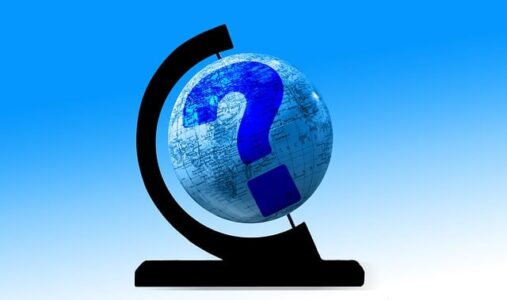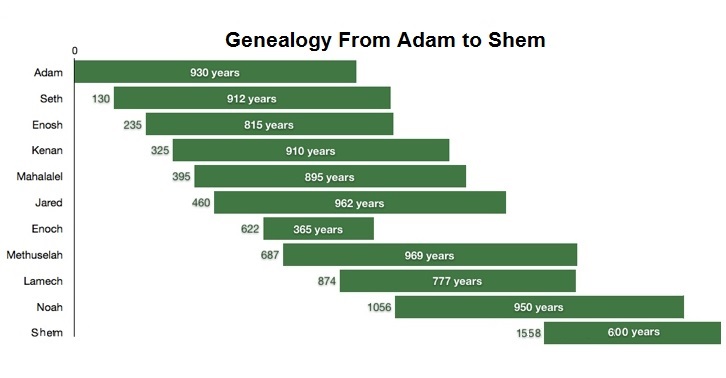
ב''ה
 Subscribe to our
Subscribe to ourThe 70 Biblical nations of the world came from and are named after the 70 descendants of the three sons of Noah: Yafes [Japheth], Ham and Shem (Gen. 10:1-32).

The African peoples (non-Arabic) are among the descendants of Ham, and East Asians are among the descendants of Yafes.
It is important to note that the ruthless king of the Babylonian empire, Nebuchadnezzar, forcibly mixed the original nations which he conquered so they would lose their independent national identities. For example, the Talmud (Sanhedrin 59b) states that the original Ishmaelites became intermingled with the other nations that were descended from Abraham and Keturah.
Likewise, it is established as Torah law that the original Egyptians, Moabites and Ammonites can no longer be identified. The only conquered peoples which Nebuchadnezzer did not intermingle were the Jewish exiles of Judea, and of course his own Babylonian people. The Lubavitcher Rebbe, Rabbi Menachem M. Schneerson, pointed out that within the modern country of Iraq, there are still a significant number of these ethnic Babylonians.
Twenty-six of the 70 Biblical nations descended from Shem. The Torah names them in Gen. 10:21-31. For a complete commentary on the identity of these nations in modern terms, see Artscroll’s Bereishis (Genesis), vol. I, pp. 308-332. This source provides many of the points below.
Noah originally apportioned the Asian continent to Shem and his descendants. This included the land that is now Israel, but they were later forcibly displaced from there by the Canaanite nations, who descended from Ham, Noah’s middle son (Gen. 10:6). (See Rashi’s comment on Gen. 12:6.) Shem was the original king of Jerusalem (which they called “Salem”), and he was known as Malkizedek (“Righteous King,” Gen. 14:18).
We will now enumerate the 26 Biblical nations descended from Shem, which are included in the total of the 70 nations of the Children of Noah.
(1) Elam: Their territory was between Shushan (in Persia) and Media. In the days of Abraham (before Abraham had children), the nation of Elam had a king named Chedarlaomer (Gen. 14:1). He ruled by force over the five kingdoms of the metropolis of Sodom and Gomorrah. When those servant kingdoms rebelled against him, Chedarloamer allied himself with three other kings (including Amraphel = Nimrod) to fight and defeat them, as described in Gen. 14:1-16. Abraham subsequently fought and defeated the four kings in order to save his nephew Lot, whom they had kidnapped from Sodom.
(2) Asshur: Asshur became the nation of Assyria, located to the north of Babylon. Genesis 10:11-12 mentions an individual with this name, in the story of the Tower of Babel. Rashi comments that when he saw that his children were listening to the wicked Nimrod and rebelling against G-d by building the Tower, he departed from them. He built several cities, including the famous Nineveh, which was known as “a great city unto G-d” (i.e. dedicated to G-d) (Jonah 3:3).
(3) Arpachshad: According to Josephus, he was the ancestor of the Chaldeans. They first lived in the coastal area of the lower Euphrates, and later moved inland. Ur, the birthplace of Abraham, was one of their main cities.
(4) Lud: Josephus seems to identify them with the Lydians of Asia Minor.
(5) Aram: These are the Arameans, who lived in the area of Syria, with Damascus as their capital.

These are: (6) Uz, (7) Hul, (8) Gether and (9) Mash.
Hul: Joshephus identifies this land as Armenia.
Mash: There is a Mount Mash in Mesopotamia that may have been named after this nation.
Arpachshad had one son who became a nation – (10) Shelah, who was the father of Eber (or Ever).
(11) Eber: Eber was the great-grandson of Shem. He, along with Shem, received prophecy and was one of the great righteous people of the generations. Eber and Shem established an academy of Torah learning. They both outlived Abraham. Eber became a nation, and he had two sons who became nations – (12) Peleg and (13) Joktan.
Peleg: Abraham descended by 5 generations from Peleg. The dispersion of the nations from the Tower of Babel in Babylonia (present-day Iraq), occurred in the year of Peleg’s death. (See Rashi’s comment on Gen. 10:25.) There is a city of Palga at the junction of the Euphrates and Chaboras rivers.
Joktan: He had the following 13 sons. Most of them are associated with nations that settled in the area of Arabia. Genesis 10:30 states, “their settlement was from Mesha, as you come to Sephar, the mountain of the east.” In “Antiquities of the Jews,” Josephus wrote, “These inhabited from Cophen, an Indian river [now called the Kabul River], and in part of Aria adjoining to it,” which is in eastern Afghanistan.
(14) Almodad
(15) Sheleph
(16) Hazarmaveth: He is identified with Hadarmaveth in Southern Arabia.
(17) Jerah
(18) Hadoram: Doram is the name of a fortress in Southern Arabia.
(19) Uzal: This is the original name of the San’a, the Arabian name for the capital of Yemen.
(20) Diklah: Diklah is used to refer to the palm-tree region in Judea.
(21) Obal: The Samaritans refer Obal to the Mt. Eibal region in Samaria, near Shechem.
(22) Abimael
(23) Sheba: Sheba is mentioned as a distant, wealthy people who were renowned for their gold, precious stones and frankincense. The Queen of Sheba became famous through her meeting with King Solomon. (I Kings 10:2,10) Some identify them with the Sabaeans of Southwest Arabia.
(24) Ophir
(25) Havilah: Havilah is to the southeast of Arabia toward the Persion Gulf and India. There is a place Havilah in Bahrein on the Persian Gulf.
(26) Jobab: Jobab is identified as the Egyptian coastal city of Jobabiti.
G-d caused the original nations to disperse by dividing them with different languages because they rebelled against Him with the Tower of Babel (Genesis 11:1-8). G-d simultaneously sent physical destruction against the people and their tower. He sent a massive storm of hail onto the people (Tur on Genesis 11:8), and a tidal wave from the sea that drowned almost half of the population (Midrash Genesis Rabbah 38:10).
The Midrash (ibid.) says that 30 of the national families were wiped out. The 30 nations that arose later from the descendants of Abraham replaced them. Of these, 16 were from the children of Abraham and Keturah (Genesis 25:2-4); Abraham sent them away to the east. Twelve were from the sons of Abraham’s son Ishmael; they settled between Egypt and Assyria (Genesis 25:13-18). This accounts for 28 nations.
Genesis Rabbah (ibid.) cites Genesis 25:23 to identify the remaining two as descendants of Abraham’s son Isaac – Israelites from Jacob and Edomites from Esau. But that was not a permanent situation. The Israelites who survived their exile in Egypt, and became the Jewish people at Mount Sinai, were separated by G-d from the Gentile nations. For example, during the Temple services for the 7 days of Sukkot, the priests offered 70 bulls to bring blessings to the 70 Gentile nations. On the next day, Shemini Atzeret, the one bull that was offered represented the Jewish people.
Furthermore, the nation of Midian that descended from Abraham and Keturah was destroyed before the Israelites entered their Promised Land. Perhaps the two Gentile nations that completed the number of 70 at that time were those descended from Lot, the son Abraham’s brother Haran. Lot, through his two daughters, fathered Moab and Ammon after the destruction of Sodom and Gomorrah (Genesis 19:29-38).
The Biblical nations of Moab and Ammon, on the eastern border of the Land of Israel, are the Kenizzite and Kadmonite who are prophetically listed in Genesis 15:19. (Edom is the Kenite, the third nation that is listed there.) In other words, at the time that G-d spoke to Abraham in Genesis 15:19, the forefathers of the Kenite, Kenizzite and Kadmonite nations, whose lands would lie between the Jordan and Euphrates rivers, had not yet been born!
Abraham’s brother Nahor was the grandfather of Laban and Rebecca (the wife of Isaac). Laban was the father of Rachel and Leah (from his main wife), and Bilhah and Zilpah (from his concubine). They became the four wives of Jacob. The wicked prophet Bilaam (Numbers chs. 22-24) descended from Laban.
Abraham was 58 when Noah died at the age of 950. He was acquainted with Noah and was taught by him. (The numerical value of Noah’s name in Hebrew, No’ach, is 58, hinting that Abraham continued the holy work of Noah.) Noah was in the first generation after Adam died. He received the Oral Tradition of kabbalistic secrets of creation directly from those who learned directly from Adam, and he and Shem taught Abraham. Abraham transmitted those teachings to Isaac, then to Jacob, and then to Jacob’s 12 sons. Isaac and Jacob also spent time learning in the academy (yeshiva) of the prophets Shem and Eber.